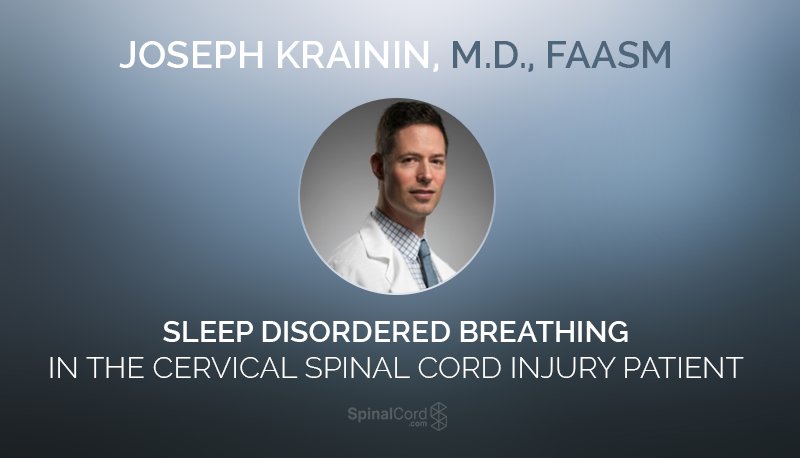Sleep Disordered Breathing in the Cervical Spinal Cord Injury Patient

Editor’s note: This is a guest post that was provided by an outside contributor and does not necessarily reflect the opinions of SpinalCord.com.
Cervical SCI patients are at an increased risk for several sleep breathing disorders that, left undiagnosed and untreated, may negatively affect the patient's health and well-being. The following case illustrates some of the challenges that SCI patients face in management of sleep disorders. The patient's name has been changed to protect her privacy.
The Case of a Cervical Spine Injury
"Diane" sustained a complete C5 cervical spinal cord injury as an unrestrained passenger in a motor vehicle accident in 2003. Notably, Diane had experienced an approximately 50-pound weight gain since the injury, which she attributed to the inability to lead the active lifestyle that she had previously enjoyed prior to the accident. Her BMI was now 32 (>30 is considered obese). For the past several years she had experienced increasing sleep disruption and on rare occasion she had woken up with a feeling of gasping for air. Her morning caregiver had commented to the patient that she had noticed significant snoring on several occasions upon awakening her. Additionally, she had become increasingly sleepy during the day, frequently dozing off while watching TV and movies.
She had mentioned these symptoms to her physician who had referred her for a sleep study. However, her local sleep lab informed her that they did not offer the level of care needed to perform sleep studies on quadriplegics. The nearest sleep center that could accommodate her was at an academic medical center located approximately a two hours' drive from Diane's home. The idea of sleeping in a foreign environment was unappealing to Diane so she researched alternatives. She learned about Singular Sleep's home sleep testing program through an Internet search and she found the idea of a home sleep study to be appealing. After discussing the situation with our office manager, she placed an order for a home sleep test.
The Impact of SCI on Sleep Disorders
Diane's history and SCI predisposed her to two sleep breathing disorders: obstructive sleep apnea and sleep-related hypoxemia. Obstructive sleep apnea (OSA) is characterized by repetitive closure of the upper airway and obesity is a major risk factor for the disorder. Snoring is usually associated with OSA. OSA has been implicated in numerous medical conditions, including heart attack, cardiac arrhythmias, stroke, high blood pressure and diabetes.
Sleep-related hypoxemia is a condition where oxygen levels in the body are too low (<90%) for sustained periods of time during sleep. The diaphragm is the major muscle that controls breathing. This critical muscle is controlled by the phrenic nerve, which is comprised of inputs from the C3, C4, and C5 nerve roots, but primarily C4. If the diaphragm is weakened, which can occur from a number of condition including cervical SCI, it can lead to sleep-related hypoxemia. This disorder is can contribute to certain dangerous heart and lung diseases. Diane's SCI level was a risk factor for this disorder.
Diane reported that the study was easy to set up and perform with the help of her caregivers. The study's results revealed obstructive sleep apnea, but there was no evidence of sleep-related hypoxemia, meaning that Diane's diaphragm was functioning well.
Sleep apnea is divided into 3 categories:
- Mild (AHI 5-15)
- Moderate (AHI 15-30)
- Severe (AHI >30)
The AHI refers to the average number of abnormal breathing events per hour. Diane had an apnea-hypopnea index (AHI) of 24, consistent with moderate obstructive sleep apnea.
Diane then participated in a telemedicine consultation with me with minimal assistance from one of her caretakers. She reported that she liked the fact that she didn't need to leave her home to have the appointment with me. I reviewed the study results, the health implications of the sleep apnea and the treatment options. Diane elected to pursue auto-CPAP (APAP), the gold standard treatment for OSA. This device uses air pressure to pneumatically splint the upper airway open, thereby treating the OSA. Unlike the original fixed-pressure CPAP machines, APAP gives "on-demand" pressure; this means that the machine is continually adjusting to provide the minimum pressure needed to keep the airway open. Many patients find APAP to be considerably more comfortable and effective than fixed-pressure CPAP.
The Results of Proper Sleep Treatment
During a follow-up telemedicine consultation two months later, we reviewed the compliance data from her machine. Diane exhibited excellent usage, averaging 7 hours and 20 minutes of nightly use. The machine's estimates of residual breathing events and system leak were unremarkable. Diane reported that her sleep quality was significantly improved. She now generally felt refreshed upon awakening in the morning and had near-total resolution of her excessive daytime sleepiness.
This case illustrates the importance of screening for sleep breathing disorders in cervical SCI patients. Home sleep apnea testing and sleep telemedicine are novel diagnostic options which may be advantageous for the SCI patient.
Stay Updated on Advancements On Traumatic Brain &
Spinal Cord Injuries
About the Author




